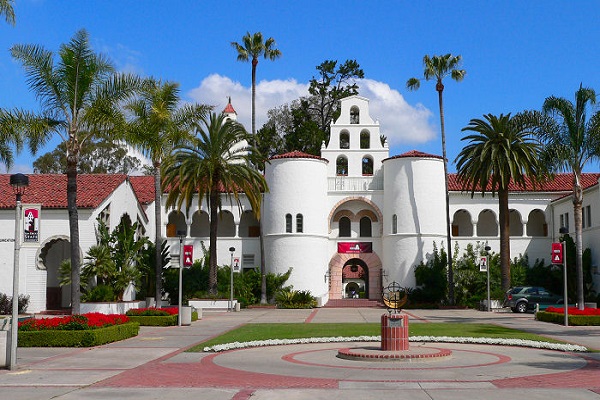LPC West Chosen As First Developer for Innovation District By San Diego State University
San Diego State University has announced that following a competitive selection process, LPC West has been chosen to complete the first innovation district project at SDSU Mission Valley, which will dramatically expand educational and workforce opportunities for San Diego’s students, faculty, and researchers.
The proposed project at SDSU Mission Valley will deliver approximately 315,000 square feet of leading-edge facilities for research and innovation in three buildings in the northeast portion of the innovation district site area. The project will also include community-serving amenities, a business incubator and accelerator space, and other workforce development opportunities that will intersect to produce a highly dynamic gathering place. LPC West will also construct two parking structures to support innovation district uses as well as nearby stadium events.
The selection of LPC West is the first step in the development of the innovation district at SDSU Mission Valley. With a planned 1.6 million square feet of office, technology, laboratory and research space at full build-out, the innovation district will ultimately consist of several hubs where particular areas of focus are approached through transdisciplinary collaboration and partnerships.
“This is momentous for SDSU,” said SDSU President Adela de la Torre. “The innovation district is the very heart of SDSU Mission Valley. It is the vital step in reaching our educational, research, and economic goals as a university, which is critically linked to the workforce needs of the region.
“Everything about the innovation district is about enhancing research activity and providing leading-edge educational experiences for our students so that we can accelerate the future economic growth of San Diego. For the first time since we moved to the Mesa, it will also give our campus the sheer space to grow. Every aspect of this project is designed to support itself financially, and to strengthen our collaboration with the private sector so that we can turbocharge our contribution to the region’s economy.”
Following approval by the California State University Board of Trustees, LPC West anticipates construction would begin in 2024, with occupancy in 2026.
LPC is one of the largest full-service real estate firms in the U.S., and its west-coast arm LPC West is responsible for a portfolio of over 30 million square feet of commercial and life science space. The firm also has several university-affiliated developments, including an innovation district at North Carolina State and projects at the University of Washington.
“LPC West is excited to leverage San Diego’s incredible climate, active community, and innovative startups to attract the nation’s best-in-class researchers and facilitate meaningful relationships between the university, students and alumni, and local businesses and entrepreneurs,” said Scott Moffatt, Executive Vice President, San Diego Region, LPC West.
Within the project, LPC West is designing a flexible and diverse range of suites and spaces to accommodate various program types, from coworking incubator labs to mid-sized office suites and larger anchor tenants. This is critical to providing collaborative research partnerships, attracting first-rate employers, and enabling more opportunities for public engagement and interaction with private industry partners.
LPC West is also focused on providing an engaging outdoor environment that includes plazas, public art, beautiful landscaping, and layered amenities that pave the way for casual meetings and collaborations as people run into each other and discuss new ideas, ventures, and opportunities.
In addition to creating a vital economic catalyst that supports the San Diego region, the innovation district will help SDSU reach its strategic plan goals of enhancing the university’s standing as a leading research institution by providing opportunities for students, faculty, and researchers.
“As SDSU continues to ascend as a top national research institution, SDSU is excited to partner with LPC West to realize our vision of collaboration with public and private partners to develop solutions that respond to urgent societal challenges,” said Hala Madanat, Vice President for Research & Innovation at SDSU.
SDSU plans to occupy approximately 50,000 square feet of research space within the LPC West project. Other expected partners that will co-locate within this first project include QuidelOrtho, Naval Health Research, and Family Health Centers. QuidelOrtho, which was the first innovation district partner announced in July 2022 with plans to locate research and development activities within the first project, is one of the world’s largest pure-play in vitro diagnostics providers designed for point-of-care settings, clinical labs, and transfusion medicine.
SDSU and LPC West continue to seek more private, public, and non-profit-sector partners who will contribute to interdisciplinary hubs of research and innovation, with future partnership announcements expected soon.
Continuing SDSU’s commitment to achieving a sustainable future, LPC West will pursue Healthy Building Certifications, including a minimum design of LEED Silver, with an emphasis on water conservation, energy efficiency, and carbon reduction.
LPC West has engaged Swinerton as the general contractor, Lever as the lead design architect, Ferguson Pape Baldwin Architects (FPBA) as the associate architect, and James Corner Field Operations (JCFO) as the landscape architect. JCFO led the design for the High Line at the Rail Yards in New York, as well as Cornell Tech Campus. LPC West also plans to incorporate mass timber as an architectural statement; with Timberlab serving as the mass timber technical advisor.
SDSU is being supported by national experts at HR&A Advisors, Inc. who have successfully implemented similar innovation districts across the country.
In addition to the innovation district, SDSU Mission Valley will include 80 acres of parks and open space, up to 4,600 market-rate and affordable housing units, 90,000 sq. ft. of retail space, and a hotel.

